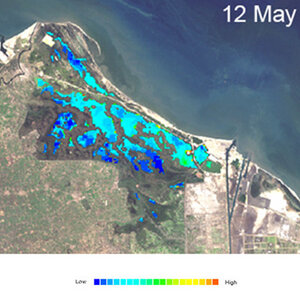Monitoring water resources in the Mediterranean
The effects of climate change, population growth and economic development in the Mediterranean are posing a threat to the water supply in the region. As part of ESA’s TIGER initiative, satellite data are supporting water management by identifying water resources.
The demand for water is growing around the Mediterranean and is especially crucial in areas that do not receive regular rainfall. This is especially true for the southernmost parts of Europe and the countries lying along the African coast and in the eastern Mediterranean Basin.
Owing to the increasing population, the demand for water is growing for drinking and irrigation, representing 70–80% of the water use in the region. To get a better grip on water management, satellites are increasingly acknowledged as indispensable tools for collecting information on available water resources and their use.
This information is also necessary for planning infrastructure, such as where to build a dam, how to divert a waterway or manage a flood event.
The ten-year TIGER initiative exploits Earth observation technologies in order to respond to the urgent need for reliable water information in Africa.
TIGER is currently collaborating with the Euro-Mediterranean Information System on Know-How in the Water Sector (EMWIS), organising water observation systems and building capacity in the Mediterranean region.
In this context, a short training session and workshop was organised in early December at ESA’s ESRIN centre in Frascati, Italy, with participants representing national water authorities and remote sensing institutions from Morocco, Tunisia, Egypt, Lebanon and Jordan.

“The collaboration initiated with ESA is very promising,” said Eric Mino, manager of EMWIS Technical Unit.
“Earth observation can not only increase knowledge on the water cycle and irrigation efficiency at river basin level, but also provides comparable, independent and objective information across the boundaries.
“This is necessary for all international water initiatives in the Mediterranean region, in particular for the projects initiated by the Union for the Mediterranean.”
In Egypt, satellite data are being used for monitoring rice fields – a crop that requires a significant amount of water and is mainly grown in the Nile Delta. Satellite observation on land cover maps combined with indicators on the vegetation status and land-surface temperature help to improve crop irrigation management.
Between Egypt’s arid climate and high water consumption, it is important to keep an eye on water quantity, as well as quality. To estimate the quantity lost by evaporation, information on land-surface temperature is used based on satellite data.
Satellite imagery is also used to observe wetland environments and monitor changes in coastlines and river banks, such as the Nile.
High-resolution imagery from the upcoming Sentinel-2 mission, being developed under Europe’s Global Monitoring for Environment and Security (GMES) programme, is expected to improve crop mapping and support water management in the Mediterranean Basin.















 Germany
Germany
 Austria
Austria
 Belgium
Belgium
 Denmark
Denmark
 Spain
Spain
 Estonia
Estonia
 Finland
Finland
 France
France
 Greece
Greece
 Hungary
Hungary
 Ireland
Ireland
 Italy
Italy
 Luxembourg
Luxembourg
 Norway
Norway
 The Netherlands
The Netherlands
 Poland
Poland
 Portugal
Portugal
 Czechia
Czechia
 Romania
Romania
 United Kingdom
United Kingdom
 Slovenia
Slovenia
 Sweden
Sweden
 Switzerland
Switzerland




























